Royal Fleet Auxiliary
The Royal Fleet Auxiliary is the fifth fighting arm of the Royal Navy. It is made up of civilian-crewed ships operated by the Ministry of Defence. It provides vital – and highly valued – logistical and operational support to the Royal Navy and Royal Marines. A committed team of personnel makes sure the Royal Navy and Royal Marines are well supplied and well supported, providing medical care, transporting kit, fuel and other essentials all over the world. In addition the RFA provides humanitarian aid, undertakes counter piracy patrols, counter narcotic operations, defence diplomacy together with assisting in preventing conflict or safeguarding the flow of international trade as single units.[2] They are the uniformed civilian branch of the Naval Service, staffed by UK merchant sailors.[3]
| Royal Fleet Auxiliary | |
|---|---|
 | |
| Active | 1905–Present |
| Country | United Kingdom |
| Type | Auxiliary force |
| Role | Replenishment & Operational Support |
| Size | 1,900 personnel[1] 337,000 tonnes |
| RFA Headquarters | Leach Building, Whale Island, Portsmouth, England, UK |
| Colours | Blue and gold |
| Fleet |
|
| Decorations | Queen's Colour |
| Website | Royal Fleet Auxiliary |
| Commanders | |
| Commodore in Chief | The Earl of Wessex |
| Commodore RFA | Cdre Duncan Lamb |
| Insignia | |
| Royal Fleet Auxiliary Ensign |  |
| Royal Fleet Auxilllary Jack | 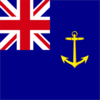 |
| Abbreviation | RFA |
The RFA counts an Aviation Training ship/Hospital Ship and landing vessels amongst its assets. RFA personnel are employees of the Ministry of Defence, and since 2003, special members of the Royal Naval Reserve deemed sponsored reserves, which are civilians who must be part of the Armed Forces in some capacity, in order to carry out specialist civilian jobs in a military capacity. Although RFA officers wear Merchant Navy rank insignia with naval uniforms, they are classed as a part of the naval service and are under naval discipline when the vessel is engaged on warlike operations. RFA vessels are commanded and crewed by these officers and ratings, augmented with regular and reserve Royal Navy personnel to perform specialised functions such as operating and maintaining helicopters or providing hospital facilities. Royal Navy personnel are also needed to operate certain weapons, such as the Phalanx, however other weapons (such as the Bushmaster 30mm cannon, Oerlikon 20mm cannon, GPMG and the 7.62 minigun) are operated by RFA personnel.
History
_refueling_USS_Donald_Cook_(DDG_75)_070303-N-5459S-007.jpg)
The RFA was first established in 1905 to provide coaling ships for the Navy in an era when the change from sail to coal-fired steam engines as the main means of propulsion meant that a network of bases around the world with coaling facilities or a fleet of ships able to supply coal were necessary for a fleet to operate away from its home country. Since the Royal Navy of that era possessed the largest network of bases around the world of any fleet, the RFA at first took a relatively minor role.
The RFA firstly became heavily relied on by the Royal Navy during World War II, when the British fleet was often far from available bases, either due to the enemy capturing such bases, or, in the Pacific, because of the sheer distances involved. World War II also saw naval ships staying at sea for much longer periods than had been the case since the days of sail. Techniques of Replenishment at Sea (RAS) were developed. The auxiliary fleet comprised a diverse collection, with not only RFA ships, but also commissioned warships and merchantmen as well. The need for the fleet to be maintained was unambiguously demonstrated by World War II.
After 1945, the RFA became the Royal Navy's main source of support in the many conflicts that the Navy was involved in. The RFA performed important service to the Far East Fleet off Korea from 1950 until 1953, when sustained carrier operations were again mounted in Pacific waters. During the extended operations of the Konfrontasi in the 1960s, the RFA was also heavily involved. As the network of British bases overseas shrank during the end of the Empire, the Navy increasingly relied on the RFA to supply its ships during routine deployments.
The RFA played an important role in the largest naval war since 1945, the Falklands War in 1982 (where one vessel was lost and another badly damaged), and also the Gulf War, Kosovo War, Afghanistan Campaign and the 2003 invasion of Iraq.
In July 2008, the RFA was presented with a Queen's Colour, an honour unique to a civilian organisation.[4][5][6]
Fleet
|
|
| Ships of the Royal Fleet Auxiliary |
|
A -
B -
C -
D -
E -
F -
G |
| Amphibious warfare ships |
| Replenishment ships |
| Miscellaneous ships |
Ships in RFA service carry the ship prefix RFA, standing for Royal Fleet Auxiliary, and fly the Blue Ensign defaced with an upright gold killick anchor. All Royal Fleet Auxiliaries are built and maintained to Lloyd's Register and Department for Transport standards.
The most important role provided by the RFA is replenishment at sea (RAS), therefore the mainstay of the current RFA fleet are the replenishment ships.[7] The Wave-class are 'Fleet Tankers', which primarily provide under way refuelling to Royal Navy ships, but can also provide a limited amount of dry cargo. The Rover-class that were decommissioned in 2017 are being replaced by the new Tide-class 'Fast Fleet Tankers' that were ordered in February 2012. The four new tankers have been ordered from DSME, South Korea with design support from Britain's BMT Defence Services, the first of which Tidespring entered service in 2017.[8] The 2015 Strategic Defence and Security Review confirmed that three "Fleet Solid Support" Ships were to be built and bidding for the contract was to have started in late 2016.[9] However, late in 2019 this competition was stopped in the face of criticism that the competition permitted the potential construction of the ships outside the UK. Prior to the COVID-19 pandemic, this competition was anticipated as likely to be re-started in 2020 with revised terms of reference.[10]
Fort Victoria is a 'one-stop' replenishment ship, capable of providing under way refuelling and dry cargoes (I.e rearming, victualling and spares). The older Fort Rosalie-class ships provide only dry cargoes. The Wave-class, Fort Victoria and the Fort Rosalie-class have generous aviation facilities, providing aviation support and training facilities and significant vertical replenishment capabilities. They are capable of operating and supporting several Merlin and Lynx Wildcat helicopters, both of which are significant weapons platforms. The presence of aviation facilities on RFA ships allows for them to be used as 'force multipliers' for the task groups they support in line with Royal Navy doctrine.
The RFA is tasked with the role of supporting Royal Navy amphibious operations through its three Bay-class dock landing ships (LSD). Typically one Bay-class is also assigned as a permanent 'mothership' for Royal Navy mine countermeasures vessels in the Persian Gulf.
The unique support ship in the fleet is the aviation training ship Argus, a converted roll-on/roll-off (RoRo) container ship. She is tasked with peacetime aviation training and support. On active operations, she becomes the Primary Casualty Receiving Ship (PCRS); essentially a hospital ship. She cannot be described as such – and is not afforded such protection under the Geneva Convention – as she is armed. She can, however, venture into waters too dangerous for a normal hospital ship. Argus completed a refit in May 2007 intended to extend her operational life to 2020.[11]
The Point-class sealift ships were acquired in 2002 under a £1.25bn private finance initiative with Foreland Shipping known as the 'Strategic Sealift Service'. These ships are Merchant Navy vessels leased to the Ministry of Defence as and when needed. Originally six ships were part of the deal, allowing the MoD use of four of the ships with two being made available for commercial charter, these latter two were released from the contract in 2012.[12] The Ministry of Defence also maintains a single commercial tanker under permanent charter, the Maersk Rapier.[13] The ship is tasked with supplying fuel to the United Kingdoms various naval establishments at home and overseas, as well as providing aviation fuel to RAF stations at Cyprus, Ascension and the Falklands.[13] The MoD charters the vessel to commercial companies during periods where she is not in use for defence purposes.[13][14]
As of 2020, there are 13 ships in service with the Royal Fleet Auxiliary with a total displacement of approximately 376,000 tonnes. These figures exclude the four merchant navy vessels under charter to the Ministry of Defence.
Replenishment
| Class | Ship | Pennant No. | Entered service | Displacement | Type | Note |
|---|---|---|---|---|---|---|
| Tide-class | RFA Tidespring | A136 | 2017 | 39,000 tonnes | Replenishment tanker | [15] |
| RFA Tiderace | A137 | 2018 | [16] | |||
| RFA Tidesurge | A138 | 2019 | [17] | |||
| RFA Tideforce | A139 | 2019 | [18] | |||
| Wave-class | RFA Wave Knight | A389 | 2003 | 31,500 tonnes | Fast fleet tanker | [19] |
| RFA Wave Ruler | A390 | 2003 | [20] | |||
| Fort Victoria-class | RFA Fort Victoria | A387 | 1994 | 33,675 tonnes | Multi-role replenishment ship | [21] |
| Fort Rosalie-class | RFA Fort Rosalie | A385 | 1978 | 23,384 tonnes | Solid replenishment ship | [22] |
| RFA Fort Austin | A386 | 1979 | [23] | |||
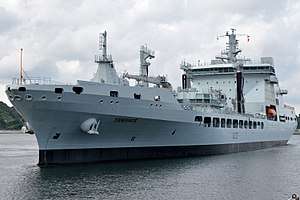 Tiderace (Tide-class)
Tiderace (Tide-class) Wave Knight (Wave-class)
Wave Knight (Wave-class)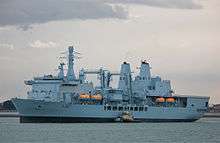 Fort Victoria (Fort Victoria-class)
Fort Victoria (Fort Victoria-class).jpg) Fort Austin (Fort Rosalie-class)
Fort Austin (Fort Rosalie-class)
Dock landing ships
| Class | Ship | Pennant No. | Entered service | Displacement | Type | Note |
|---|---|---|---|---|---|---|
| Bay-class | RFA Lyme Bay | L3007 | 2007 | 16,160 tonnes | Dock landing ship auxiliary | [24] |
| RFA Mounts Bay | L3008 | 2006 | [25] | |||
| RFA Cardigan Bay | L3009 | 2006 | [26][N 1] | |||
_maneuvers_into_position_to_receive_a_U.S._Navy_MH-60S_Knighthawk_helicopter_assigned_to_Helicopter_Sea_Combat_Squadron_(HSC)_26_in_130520-N-OA702-044.jpg) Cardigan Bay (Bay-class)
Cardigan Bay (Bay-class)
Aviation Support/Casualty Evacuation
| Class | Ship | Pennant No. | Entered service | Displacement | Type | Note |
|---|---|---|---|---|---|---|
| — | RFA Argus | A135 | 1988 | 28,081 tonnes | Aviation training & primary casualty receiving ship | [27] |
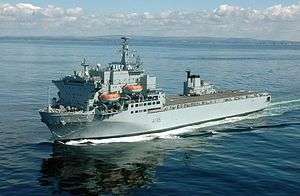 Argus
Argus
Ministry of Defence
| Class | Ship | Owner | Entered service | Displacement | Type | Note |
|---|---|---|---|---|---|---|
| Point-class | MV Hurst Point | Foreland Shipping | 2002 | 23,000 tonnes | Ro-Ro Sealift | [28] |
| MV Eddystone | 2002 | [28] | ||||
| MV Hartland Point | 2002 | [28] | ||||
| MV Anvil Point | 2003 | [28] | ||||
| — | MV Maersk Rapier | A.P. Moller–Maersk Group | 2003 | 37,000 DWT | Tanker | [29] |
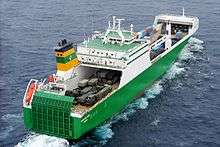 Hartland Point (Point-class)
Hartland Point (Point-class)
Rank insignia
Officers
Rank insignia of RFA officers are the same as for the Royal Navy; however, the RFA makes use of the diamond used by merchant shipping rather than the loop used by the RN. The rank of commodore is the most senior in the RFA.
| Rank | Commodore | Captain | Chief Officer | First Officer | Second Officer | Third Officer | Cadet |
|---|---|---|---|---|---|---|---|
| Insignia | |||||||
| Abbreviation | Cdre | Capt | C/O | 1/O | 2/O | 3/O | Cdt |
| Analogous RN Rank* | Commodore | Captain | Commander | Lieutenant
Commander |
Lieutenant | Sub Lieutenant | Midshipman |
Department Colours
The RFA uses distinctive cloth to distinguish the branch of its officers. The Royal Navy ceased this practice for most officers in 1955, with the exception of medical and dental officers who are denoted by red and pink cloth respectively.
| Deck (X) | Logistics and Supply (LS) | Marine Engineering (ME) | Systems Engineering (SE) | Communications |
|---|---|---|---|---|
| unadorned |
Marine Engineers may also have maroon coloured cloth in place of purple.
Rates
 Chief Petty Officer (Communications)
Chief Petty Officer (Communications) Petty Officer (Deck)
Petty Officer (Deck) Petty Officer (Communications)
Petty Officer (Communications) Leading Hand (Communications)
Leading Hand (Communications) Seaman Grade 1
Seaman Grade 1 Seaman Grade 2
Seaman Grade 2 Apprentice
Apprentice
Uniforms
Ofiicers and Ratings of the RFA wear similar uniforms to the Royal Navy with RFA distinguishing marks.
No. 1 Dress
This is the formal uniform worn on ceremonial occasions. For all commissioned officers it consists of a double-breasted, navy blue reefer jacket with four rows of two RFA buttons; matching trousers; white shirt and black tie; peaked cap; and black leather shoes. Rank insignia is denoted on the lower sleeve.
For ratings this uniform is a single breasted tunic fastened with four RFA buttons, with flapped chest pockets and hip pockets; white shirt and black tie, peaked cap for Petty Officers and above and a light blue beret for other ratings; and black leather shoes. Rank insignia is denoted on the lower sleeve.
No. 2 Dress
Number 2A dress is the formal evening dress for ceremonial dinners; it consists of a navy blue mess jacket with a white waistcoat (black cummerbund for female officers) with miniature medals. 2B is "mess undress" for other mess functions, and is worn with either a black cummerbund or navy blue waistcoat and miniature medals. 2C, "red sea rig", is worn for informal evening wear on board ship; it consists of a white short sleeved shirt, worn with shoulderboards, without medals and with black trousers, black shoes and a black cummerbund.
No. 3 Dress
This is worn all year round for general duties. It consists of a white shirt with rank insignia on the shoulders, and appropriate headgear. For officers 3A dress includes a long-sleeved shirt and tie, while 3B includes a short-sleeved shirt worn with hard shoulder boards. 3C is the same in all respects as 3A but with the addition of a navy blue woollen jersey. This is the same as for Officer's No. 3 dress but with the relevant rate insignia and beret. Junior rates are only issued with short-sleeve shirts and are not issued with ties. Thus No.3 dress is divided into 3B (without jersey) and 3C dress (navy-blue jersey worn over the shirt with the shirt collar out). There is no equivalent of 3A dress for junior ratings.
No. 4 Dress
Number 4 dress is the working uniform of the RFA. It is referred to as Royal Fleet Auxillary Personal Clothing System (RFAPCS); it consists of a navy blue fire-retardant jacket (worn tucked in and with the sleeves rolled up), navy blue beret, navy blue stable belt, navy-blue fire-retardant trousers, dms boots, navy-blue T-shirt and an optional navy-blue microfleece. Number 4R dress is the same only without the jacket and with an optional baseball cap. RFAPCS is distinguished from its RNPCS counterpart by the RFA blue ensign and 'ROYAL FLEET AUXILLARY' tape replacing the white ensign and 'ROYAL NAVY' tape worn on the left arm and left chest pocket respectively. Junior ratings may also wear an RFA badged baseball cap in this order of dress, whilst undertaking courses at Royal Navy establishments.
No. 5 Dress
Number 5 dress is the collective category for all specialist working uniforms. They are worn as required for duties.
Recruitment and Training
The RFA recruits rates either directly from industry (or where they are suitably trained to allow direct entry), or as apprentices whilst undertaking training.
Officers are recruited in one of three ways[30]
- direct from industry (or where they are suitably trained to allow direct entry)
- via the RTO (rate-to-officer) programme
- as cadets
All new officers take part in a 10 week Initial Naval Training Officers (INT-O) course at BRNC Dartmouth that is designed to familiarise new officers to the RFA and develop leadership skills.
See also
Lists of ships operated by or in support of Her Majesty's Naval Service
Related articles
- Her Majesty's Naval Service
- List of Royal Fleet Auxiliary ship names
- Merchant Navy (United Kingdom)
- Royal Research Ship
- Military Sealift Command – the United States Navy's analogue to the Royal Fleet Auxiliary
- Solid Support Ship
References
- RFA Cardigan Bay is forward deployed as command vessel of 9 Mine Countermeasures Squadron, operating from HMS Jufair in Bahrain.
- https://assets.publishing.service.gov.uk/government/uploads/system/uploads/attachment_data/file/763274/BCPR_October_2018_-_Publication.pdf
- https://www.royalnavy.mod.uk/careers/rfa Royal Navy
- https://www.royalnavy.mod.uk/our-organisation/the-fighting-arms/royal-fleet-auxiliary Royal Navy
- Journal of the Flag Institute, Issue 128, p. 20
- Gunline, April 2008, p. 7 Archived 10 March 2012 at the Wayback Machine
- Gunline, Sept 2008, p. 1 Archived 10 March 2012 at the Wayback Machine
- Britain's Modern Royal Navy, Paul Beaver, Patrick Stephens Limited, 1996, ISBN 1-85260-442-5
- "UK accepts RFA Tidespring after ten-month delay". NavalToday. Archived from the original on 26 January 2017. Retrieved 27 January 2017.
- "2015 SDSR" (PDF). Archived (PDF) from the original on 24 November 2015.
- Lye, Harry (6 November 2019). "UK MOD puts brakes on Fleet Solid Support ship tenders". Naval-technology.com. Retrieved 12 May 2020.
- BBC News: Refit of navy ship RFA Argus ends, bbc.co.uk
- Strategic Sealift Service Archived 29 November 2016 at the Wayback Machine, publications.parliament.uk, 2 Sep 2013
- Bush, Steve (2014). British Warships and Auxiliaries. Maritime Books. p. 50. ISBN 1904459552.
- Hired Tankers Hansard Written Answers – House of Commons Archived 26 October 2016 at the Wayback Machine, publications.parliament.uk, 27 October 2003
- "RFA Tidespring (official webpage)". royalnavy.mod.uk. Royal Navy. Archived from the original on 17 November 2017. Retrieved 16 November 2017.
- "NavyLookout on Twitter". Twitter. Retrieved 2 August 2018.
- "Archived copy". Archived from the original on 6 March 2019. Retrieved 5 March 2019.CS1 maint: archived copy as title (link)
- "Final Tide-class tanker joins Royal Navy fleet". Retrieved 31 July 2019.
- "RFA Wave Knight (official webpage)". royalnavy.mod.uk. Royal Navy. Archived from the original on 18 April 2015. Retrieved 23 April 2015.
- "RFA Wave Ruler (official webpage)". royalnavy.mod.uk. Royal Navy. Archived from the original on 18 April 2015. Retrieved 23 April 2015.
- "RFA Fort Victoria (official webpage)". royalnavy.mod.uk. Royal Navy. Archived from the original on 7 May 2015. Retrieved 23 April 2015.
- "RFA Fort Rosalie (official webpage)". royalnavy.mod.uk. Royal Navy. Archived from the original on 18 April 2015. Retrieved 23 April 2015.
- "RFA Fort Austin (official webpage)". royalnavy.mod.uk. Royal Navy. Retrieved 23 April 2015.
- "RFA Lyme Bay (official webpage)". royalnavy.mod.uk. Royal Navy. Archived from the original on 18 April 2015. Retrieved 23 April 2015.
- "RFA Mounts Bay (official webpage)". royalnavy.mod.uk. Royal Navy. Archived from the original on 18 April 2015. Retrieved 23 April 2015.
- "RFA Cardigan Bay (official webpage)". royalnavy.mod.uk. Royal Navy. Archived from the original on 18 April 2015. Retrieved 23 April 2015.
- "RFA Argus (official webpage)". royalnavy.mod.uk. Royal Navy. Archived from the original on 18 April 2015. Retrieved 23 April 2015.
- The Royal Navy Handbook, 2003, Ministry of Defence, page 104
- Bush, Steve (2014). British Warships and Auxiliaries. Maritime Books. p. 50. ISBN 1904459552.
- "Royal Fleet Auxiliary Logistics (RFA) Training & Development". www.royalnavy.mod.uk. Archived from the original on 20 January 2019. Retrieved 22 January 2019.
Bibliography
The Royal Fleet Auxiliary – A Century of Service. Adams/Smith. London 2005. Chatham Publishing. ISBN 1-86176-259-3.
External links
- Official website

- RFA Association Photo Archive (rfaaplymouth.org)
- The Marine Society provides a crew library service and education services to serving Merchant Navy and Royal Navy personnel.
- History of the RFA (historicalrfa.org)
